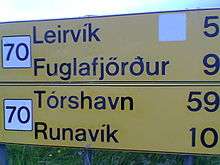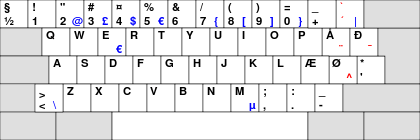Faroese orthography
Faroese orthography is the method employed to write the Faroese language, using a 29-letter Latin alphabet.
Alphabet

An example of Faroese ő. The usual orthography would be Fuglafjørður.
The Faroese alphabet consists of 29 letters derived from the Latin script:
| Majuscule forms (also called uppercase or capital letters) | ||||||||||||||||||||||||||||
|---|---|---|---|---|---|---|---|---|---|---|---|---|---|---|---|---|---|---|---|---|---|---|---|---|---|---|---|---|
| A | Á | B | D | Ð | E | F | G | H | I | Í | J | K | L | M | N | O | Ó | P | R | S | T | U | Ú | V | Y | Ý | Æ | Ø |
| Minuscule forms (also called lowercase or small letters) | ||||||||||||||||||||||||||||
| a | á | b | d | ð | e | f | g | h | i | í | j | k | l | m | n | o | ó | p | r | s | t | u | ú | v | y | ý | æ | ø |
- Eth ⟨ð⟩ (Faroese edd) never appears at the beginning of a word, which means its majuscule form, ⟨Ð⟩ rarely occurs except in situations where all-capital letters are used, such as on maps.
- ⟨Ø⟩ can also be written ⟨ö⟩ in poetic language, such as Föroyar ('the Faroes'). This has to do with different orthographic traditions (Danish-Norwegian for ⟨ø⟩ and Icelandic for ⟨ö⟩. Originally, both forms were used, depending on the historical form of the word; ⟨ø⟩ was used when the vowel resulted from I-mutation of ⟨o⟩ while ⟨ö⟩ was used when the vowel resulted from U-mutation of ⟨a⟩. In handwriting, ⟨ő⟩ is sometimes used.
- While ⟨c⟩, ⟨q⟩, ⟨w⟩, ⟨x⟩, and ⟨z⟩ are not found in the Faroese language, ⟨x⟩ was known in earlier versions of Hammershaimb's orthography, such as ⟨Saxun⟩ for Saksun.
- While the Faroese keyboard layout allows one to write in Latin, English, Danish, Swedish, Norwegian, Finnish, etc., the Old Norse and Modern Icelandic letter ⟨þ⟩ is missing. In related Faroese words, it is written as either ⟨t⟩ or ⟨h⟩. If an Icelandic name has to be transcribed, ⟨th⟩ is common.
Spelling system

Faroese keyboard layout
| Grapheme | Name | Short | Long |
|---|---|---|---|
| A, a | fyrra a [ˈfɪɹːa ɛaː] ("leading a") | /a/ | /ɛaː/ |
| Á, á | á [ɔaː] | /ɔ/ | /ɔaː/ |
| E, e | e [eː] | /ɛ/ | /eː/ |
| I, i | fyrra i [ˈfɪɹːa iː] ("leading i") | /ɪ/ | /iː/ |
| Í, í | fyrra í [ˈfɪɹːa ʊiː] ("leading í") | /ʊi/ | /ʊiː/ |
| O, o | o [oː] | /ɔ/ | /oː/ |
| Ó, ó | ó [ɔuː] | /œ/ | /ɔuː/ |
| U, u | u [uː] | /ʊ/ | /uː/ |
| Ú, ú | ú [ʉuː] | /ʏ/ | /ʉuː/ |
| Y, y | seinna i [ˈsaiːdna iː] ("latter i") | /ɪ/ | /iː/ |
| Ý, ý | seinna í [ˈsaiːdna ʊiː] ("latter í") | /ʊi/ | /ʊiː/ |
| Æ, æ | seinna a [ˈsaiːdna ɛaː] ("latter a") | /a/ | /ɛaː/ |
| Ø, ø | ø [øː] | /œ/ | /øː/ |
| EI, ei | ei [aiː] | /ai/ | /aiː/ |
| EY, ey | ey [eɪː] | /ɛɪ/ | /ɛiː/ |
| OY, oy | oy [oɪː] | /ɔi/ | /ɔiː/ |
| Grapheme | Name | IPA |
|---|---|---|
| B, b | be | /p/ |
| D, d | de | /t/ |
| >dj | /tʃ/ | |
| Ð, ð | edd | /j/, /w/, /v/, Ø |
| F, f | eff | /f/ |
| G, g | ge | /k/, /tʃ/, /j/, /w/, /v/, Ø |
| >gj | /tʃ/ | |
| H, h | há | /h/ |
| >hj | /tʃ/, /j/ | |
| >hv | /kv/ | |
| J, j | joð | /j/ |
| K, k | ká | /kʰ/, /tʃʰ/ |
| >kj | /tʃʰ/ | |
| >kk | /kː/ [ʰk] | |
| L, l | ell | /l/, [l], [ɬ] |
| >ll | /tl/ [tɬ], /lː/ | |
| M, m | emm | /m/ |
| N, n | enn | /n/ |
| >ng | /nk/ [ŋk], /ntʃ/ [ɲtʃ] | |
| >nk | /nkʰ/ [ŋkʰ], /ntʃʰ/ [ɲtʃʰ] | |
| >nj | /ɲ/, /nj/ | |
| >nn | /tn/, /nː/ | |
| P, p | pe | /pʰ/ |
| >pp | /pː/ [ʰp] | |
| R, r | err | /ɹ/ [ɹ], [ɻ] |
| S, s | ess | /s/, /ʃ/ |
| >sj | /ʃ/ | |
| >sk | /sk/, /ʃ/ | |
| >skj | /ʃ/ | |
| >stj | /ʃ/ | |
| T, t | te | /tʰ/ |
| >tj | /tʃʰ/ | |
| >tt | /tː/ [ʰt] | |
| V, v | ve | /v/ [v], [ʋ], [f] |
Glide insertion
Faroese avoids having a hiatus between two vowels by inserting a glide. Orthographically, this is shown in three ways:
- vowel + ð + vowel
- vowel + g + vowel
- vowel + vowel
Typically, the first vowel is long and in words with two syllables always stressed, while the second vowel is short and unstressed. In Faroese, short and unstressed vowels can only be /a/, /i/, /u/.
| First vowel | Second vowel | Examples | ||
|---|---|---|---|---|
| i [ɪ] | u [ʊ] | a [a] | ||
| i, y [iː] | [j] | [j] | [j] | sigið, siður, siga |
| í, ý [ʊiː] | [j] | [j] | [j] | mígi, mígur, míga |
| ey [ɛiː] | [j] | [j] | [j] | reyði, reyður, reyða |
| ei [aiː] | [j] | [j] | [j] | reiði, reiður, reiða |
| oy [ɔiː] | [j] | [j] | [j] | noyði, royður, royða |
| u [uː] | [w] | [w] | [w] | suði, mugu, suða |
| ó [ɔuː] | [w] | [w] | [w] | róði, róðu, Nóa |
| ú [ʉuː] | [w] | [w] | [w] | búði, búðu, túa |
| a, æ [ɛaː] | [j] | [v] | – | ræði, æðu, glaða |
| á [ɔaː] | [j] | [v] | – | ráði, fáur, ráða |
| e [eː] | [j] | [v] | – | gleði, legu, gleða |
| o [oː] | [j] | [v] | – | togið, smogu, roða |
| ø [øː] | [j] | [v] | – | løgin, røðu, høgan |
The value of the glide is determined by the surrounding vowels:
- [j]
- "I-surrounding, type 1" – after ⟨i, y, í, ý, ei, ey, oy⟩: bíða [ˈbʊija] (to wait), deyður [ˈdɛijʊɹ] (dead), seyður [ˈsɛijʊɹ] (sheep)
- "I-surrounding, type 2" – between any vowel (except "u-vowels" ⟨ó, u, ú⟩) and ⟨i⟩: kvæði [ˈkvɛajɛ] (ballad), øði [ˈøːjɛ] (rage).
- [w]
- "U-surrounding, type 1" – after ⟨ó, u, ú⟩: Óðin [ˈɔʊwɪn] (Odin), góðan morgun! [ˌɡɔʊwan ˈmɔɹɡʊn] (good morning!), suður [ˈsuːwʊɹ] (south), slóða [ˈslɔʊwa] (to make a trace).
- [v]
- "U-surrounding, type 2" – between ⟨a, á, e, æ, ø⟩ and ⟨u⟩: áður [ˈɔavʊɹ] (before), leður [ˈleːvʊɹ] (leather), í klæðum [ʊɪˈklɛavʊn] (in clothes), í bløðum [ʊɪˈbløːvʊn] (in newspapers).
- "A-surrounding, type 2"
- These are exceptions (there is also a regular pronunciation): æða [ˈɛava] (eider-duck).
- The past participles always have [j]: elskaðar [ˈɛlskajaɹ] (beloved, nom., acc. fem. pl.)
- Silent
- "A-surrounding, type 1" – between ⟨a, á, e, o⟩ and ⟨a⟩ and in some words between ⟨æ, ø⟩ and ⟨a⟩: ráða [ˈɹɔːa] (to advise), gleða [ˈɡ̊leːa] (to gladden, please), boða [ˈboːa] (to forebode), kvøða [ˈkvøːa] (to chant), røða [ˈɹøːa] (to make a speech)
gollark: I imagine it would still *mostly* work for a while, and people could migrate off.
gollark: It's not as if much of the internet *physically* runs through one wire or something, that would be ridiculous, it's a big internet.
gollark: I mean, the closest you would get is... maybe wiping out some important root signing key?
gollark: I run a bunch of random Discord bots and web APIs so there are something like ten mildly important things there.
gollark: I don't really have great infrastructure handling, or any, so "migration" consists of "copy service files and binaries/python or node scripts and move data over".
See also
References
- Þráinsson (2004), p. 38.
Bibliography
- Þráinsson, Höskuldur (2004), Faroese: An Overview and Reference Grammar, Føroya Fróðskaparfelag, ISBN 978-9991841854
This article is issued from Wikipedia. The text is licensed under Creative Commons - Attribution - Sharealike. Additional terms may apply for the media files.